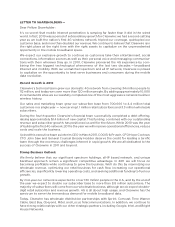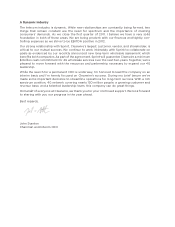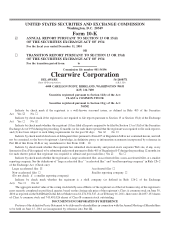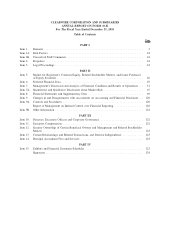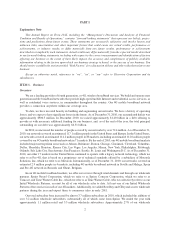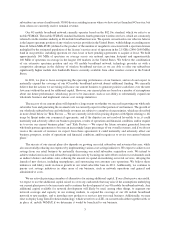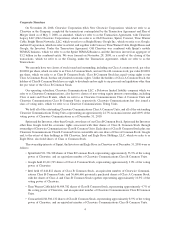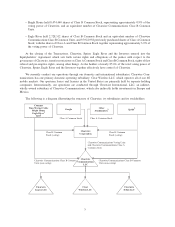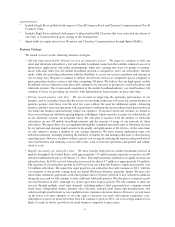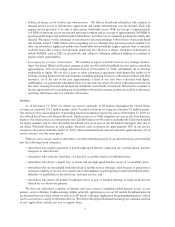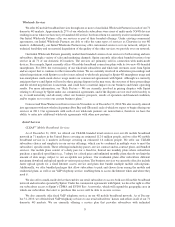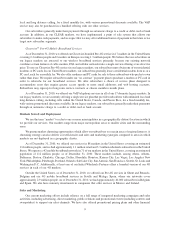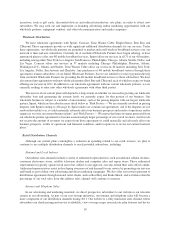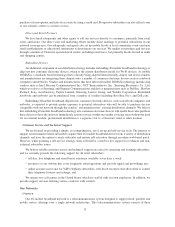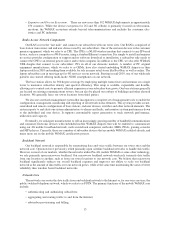Clearwire 2010 Annual Report Download - page 8
Download and view the complete annual report
Please find page 8 of the 2010 Clearwire annual report below. You can navigate through the pages in the report by either clicking on the pages listed below, or by using the keyword search tool below to find specific information within the annual report.subscribers are users of multi-mode 3G/4G devices residing in areas where we have not yet launched 4G service, but
from whom we currently receive nominal revenue.
Our 4G mobile broadband network currently operates based on the 802.16e standard, which we refer to as
mobile WiMAX. The mobile WiMAX standard facilitates fourth generation wireless services, which are commonly
referred to in the wireless industry as 4G mobile broadband services. We operate our networks over what we believe
is the largest spectrum position of any wireless service provider in the United States, with holdings exceeding more
than 46 billion MHz-POPs (defined as the product of the number of megahertz associated with a spectrum license
multiplied by the estimated population of the license’s service area) of spectrum in the 2.5 GHz (2496-2690 MHz)
band in our portfolio, including spectrum we own, lease or have pending agreements to acquire or lease. We hold
approximately 140 MHz of spectrum on average across our national spectrum footprint and approximately
160 MHz of spectrum on average in the largest 100 markets in the United States. We believe the combination
of our extensive spectrum position and our 4G mobile broadband network technology provides us with a
competitive advantage in the delivery of wireless broadband services as we are able to offer our subscribers
significantly higher mobile data bandwidth than is currently available from other wireless carriers in the United
States.
In 2011, we plan to focus on improving the operating performance of our business, and we do not expect to
materially expand the coverage of our 4G mobile broadband network absent additional funding. We currently
believe that the actions we are taking will cause our current business to generate positive cash flows over the next
few years without the need for additional capital. However, our current plans are based on a number of assumptions
about our future performance, which may prove to be inaccurate, such as our ability to substantially expand our
wholesale business and implement various cost savings initiatives.
The success of our current plans will depend to a large extent on whether we succeed in growing our wholesale
subscriber base and generating the revenue levels we currently expect for that portion of our business. The growth of
our wholesale subscriber base and wholesale revenues are subject to a number of uncertainties, which are described
in more detail below in “Risk Factors — We are currently involved in pricing disputes with Sprint relating to 4G
usage by Sprint under our commercial agreements, and if the disputes are not resolved favorably to us, it could
materially and adversely affect our business prospects, results of operations and financial condition, and/or require
us to revise our current business plans” and “Risk Factors — We expect the future revenues generated from our
wholesale partner agreements to become an increasingly larger percentage of our overall revenues, and if we do not
receive the amount of revenues we expect from those agreements it could materially and adversely affect our
business prospects, results of operations and financial condition, and/or require us to revise our current business
plans.”
The success of our current plans also depends on growing our retail subscriber and revenues this year, while
also successfully reducing our expenses by implementing various cost savings initiatives. We expect to achieve cost
savings from our retail business by materially decreasing our retail subscriber acquisition costs. We intend to
achieve reductions in our retail subscriber acquisition costs by focusing our sales efforts on lower cost channels such
as indirect dealers and online sales, reducing the amount we spend on marketing our retail services, delaying the
launch of new devices, including smartphones, and outsourcing our customer care operations. We believe these
initiatives will likely result in slower growth in our retail subscriber base in 2011. Additionally, we continue to
pursue cost savings initiatives in other areas of our business, such as network operations and general and
administrative costs.
We are actively pursuing a number of alternatives for raising additional capital. If our efforts prove successful,
we expect to use the additional capital raised to cover any cash needs that may arise if the assumptions underlying
our current plans prove to be inaccurate and to continue the development of our 4G mobile broadband network. Any
additional capital available for network development will likely be used, among other things, to augment our
network coverage and capacity in our existing markets, to expand the coverage of our 4G mobile broadband
network to new markets, and to introduce new products or services into our retail business. Additionally, we may
elect to deploy Long Term Evolution technology, which we refer to as LTE, on our networks either together with, or
in place of, mobile WiMAX if we determine it would be beneficial to our business.
3



